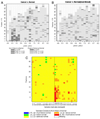The identification of phosphoglycerate kinase-1 and histone H4 autoantibodies in pancreatic cancer patient serum using a natural protein microarray
- PMID: 19582723
- PMCID: PMC2794663
- DOI: 10.1002/elps.200800857
The identification of phosphoglycerate kinase-1 and histone H4 autoantibodies in pancreatic cancer patient serum using a natural protein microarray
Abstract
Protein microarrays have been used to explore whether a humoral response to pancreatic cancer-specific tumor antigens has utility as a biomarker of pancreatic cancer. To determine if such arrays can be used to identify novel autoantibodies in the sera from pancreatic cancer patients, proteins from a pancreatic adenocarcinoma cell line (MIAPACA) were resolved by 2-D liquid-based separations, and then arrayed on nitrocellulose slides. The slides were probed with serum from a set of patients diagnosed with pancreatic cancer and compared with age- and sex-matched normal subjects. To account for patient-to-patient variability, we used a rank-based non-parametric statistical testing approach in which proteins eliciting significant differences in the humoral response in cancer compared with control samples were identified. The prediction analysis for microarrays classification algorithm was used to explore the classification power of the proteins found to be differentially expressed in cancer and control sera. The generalization error of the classification analysis was estimated using leave-one-out cross-validation. A serum diagnosis of pancreatic cancer in this set was predicted with 86.7% accuracy, with a sensitivity and specificity of 93.3 and 80%, respectively. Candidate autoantibody biomarkers identified using this approach were studied for their classification power by performing a humoral response experiment on recombinant proteins using an independent sample set of 238 serum samples. Phosphoglycerate kinase-1 and histone H4 were noted to elicit a significant differential humoral response in cancer sera compared with age- and sex-matched sera from normal patients and patients with chronic pancreatitis and diabetes. This work demonstrates the use of natural protein arrays to study the humoral response as a means to search for the potential markers of cancer in serum.
Conflict of interest statement
The authors have declared no conflict of interest.
Figures







References
-
- Jemal A, Siegel R, Ward E, Murray T, Smigal C, Thun MJ. CA Cancer J. Clin. 2006;56:106–130. - PubMed
-
- Mann DV, Edwards R, Ho S, Lau WY, Glazer G. Eur. J. Surg. Oncol. 2000;26:474–479. - PubMed
-
- Duffy MJ. Ann. Clin. Biochem. 1998;35:364–370. - PubMed
-
- Boeck S, Stieber P, Holdenrieder S, Wilkowski R, Heinemann V. Oncology. 2006;70:255–264. - PubMed
Publication types
MeSH terms
Substances
Grants and funding
LinkOut - more resources
Full Text Sources
Other Literature Sources
Medical

